A faint glow illuminated the northern sky as we packed the truck in the dark to get an early start out of Haines Junction, Yukon. At first I thought it was the glow from street lamps or maybe the start of morning twilight but then a shaft a light reached high into the sky—northern lights. We hustled out of town to a pull-out and confirmed our guess. Though faint, the glow slowly moved and an occasional ray poked high into the sky.
These northern lights (also called aurora) could’ve been easily confused with dawn which did gradually encroach on the light display. Because of this similarity, northern lights are also called “Northern Dawn” or “False Dawn”. The Latin meaning of aurora borealis is “Northern Dawn”.
The aurora can light up the sky like dawn but when active the swirling, rippling and overhead displays cannot be mistaken for anything else. Legends and folk tales provide many reasons for the aurora, including ancestors dancing in the sky, but scientists know that solar particles and gas molecules create the aurora.
The northern lights are similar to neon lights which glow when energy (in the form of electricity) is added to tubes of gas. With the northern lights, the energy comes from the sun and the atmosphere is the tube of gas. The sun emits energized particles that are carried toward earth on the solar wind. The earth’s magnetosphere (a protective shield created by the Earth’s magnetic field) prevents the majority of particles from bombarding earth but a small portion penetrates the barrier.
These energized particles collide with gas molecules in the atmosphere and transfer their energy, much like cue balls. But instead of using the energy to move across a pool table, the gas molecules emit a flash of light, which is the light we see. We cannot see just one flash; we only see the aurora when there are millions of flashes.
The light can be green, red and even blue or purple—the color depends on the gas molecule. Oxygen molecules emit green and red light, nitrogen emits violet and blue light, and hydrogen emits red light. Often seen before dawn, blue and purple aurora is caused by sunlight striking the top of extremely high rays in the atmosphere. When the aurora is weak it often appears colorless because there isn’t enough color for our eyes to detect.
The aurora can extend over a hundred miles into the atmosphere and even though it may seem to touch the horizon the lowest aurora is 40 miles above Earth’s surface. Sometimes the rays can be straight overhead or a bright band in the northern sky. Displays higher in the sky are more common at higher latitudes while mid-latitudes typically see aurora on the horizon. However, when solar activity is high, the northern lights can be seen further south, higher in the sky, and often red (which is less common).
The northern lights have been extremely active this spring and are predicted to be more active through 2013 because the solar cycle is at its maximum point. The 11-year solar cycle corresponds to the wax and wane of sunspots, with the maximum occurring during times of increased sunspot activity and the minimum occurring during minimal sunspot activity. More sunspots equates to an increased flow of energized particles carried towards earth on the solar wind.
The few hours around midnight are the best time to observe northern lights but they can be seen anytime during the night if they are extremely active. For an auroral forecast, check the University of Alaska Fairbanks Geophysical Institute’s website at http://www.gi.alaska.edu/AuroraForecast (there is even an app).
When the northern lights are swirling across the sky, I find it easy to forget about the energized particles and gas molecules creating the light and simply enjoy the show.
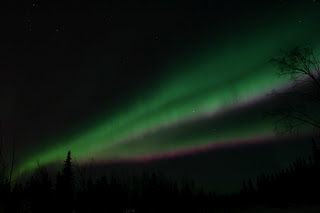 |
| A hint of red fringes green arcs of aurora. |

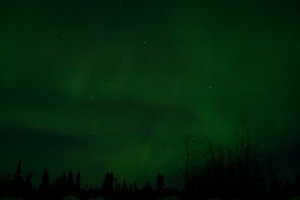
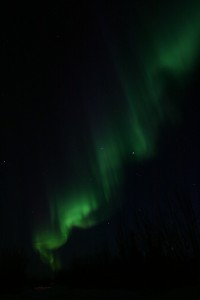

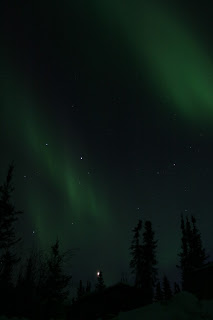
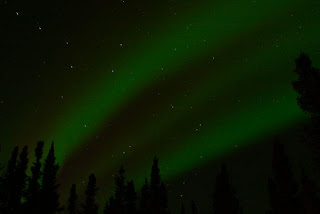
Well hello there! Did you turn to get extra help to any specific services to get more followers for this site on a regular basis? Can't wait to see your reply.